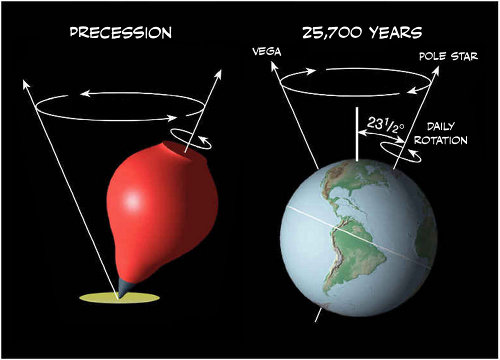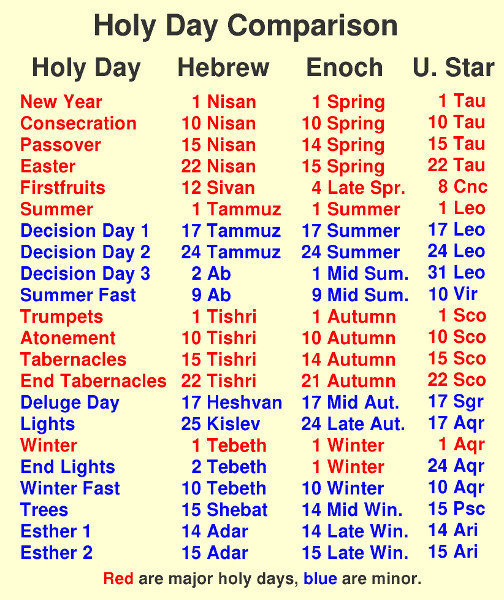
by John P. Pratt
17 Mar 2019, New Year (S), 1 Cap (US), 7 Flint (SR)
©2019 by John P. Pratt. All rights Reserved.
|
1. Feast Ages 2. Feast Star Days 3. Conclusion Notes |
The Book of Enoch describes a star calendar with 364 days, each represented by a star, which in turn represents a servant of God. Earlier articles introduced the Star Calendar based on that book, laying the groundwork that the year is divided into twelve zodiac months,[1] identifying all of the stars,[2] placing the stars in order,[3] and identifying the holy days.[4]
 |
The apparent motion of the stars through the seasons is called the "precession of the equinoxes" (see Figure 1). It is very slow, such that the star at the position of the sun on the spring equinox only changes by 1° every 72 years. This results in ages of approximately 2,000 years during which the sun rises on the spring equinox in the same zodiac. For example, the sun is now nearly finished rising in Pisces and soon will rise in Aquarius. It is this fact to which the "Age of Aquarius" refers. Before the Age of Pisces, which began with Christ, the sun rose in Aries for about 2,000 years and before that in Taurus. The 7,000 years of history of Adam's family comprises about 3.5 zodiac ages: a full age of Taurus, Aries and Pisces, and about half an age of Aquarius. All of this is explained in detail in an earlier article.[5]
 |
The rule for the precession of Star Calendar feast days appears to be very similar to the rule for Hebrew Calendar feast days. That rule is that Passover (15 Nisan) may never occur before the spring equinox. To prevent that from happening, an extra month is inserted before Nisan in the spring.
This article introduces a new concept called a zodiac "Feast Age" to refer to a period of about 2,000 years during which the Passover star day occurs in a certain zodiac constellation. As currently determined, one Feast Age changes to the next when the 15th day of the spring zodiac month first occurs on the spring equinox as determined by the Enoch Calendar. Both the Star Calendar and the Enoch Calendar intercalate entire weeks when needed, but the years are of slightly different lengths so there is no easy correlation between the two sacred calendars. The zodiac feast day of Passover always occurs beginning on a Saturday at noon, and the Enoch Spring Equinox holy day also always occurs on a Saturday, so this rule is well defined and seems to be correct.
This rule is very different from the definition of the traditional zodiac ages, such as the "Age of Aquarius". Those begin when the sun first enters a zodiac constellation on day 1 of a zodiac month on the spring equinox, whereas the Feast Ages begin when day 15 of a zodiac month falls on the equinox day. Thus, a Feast Age begins about a thousand years after the traditional Zodiac Age, or about half a zodiac age!
The result of this rule is that there are three and a half ages in 7,000 years, but they begin and end at very different times from the usual zodiac ages. The first is the Feast Age of Gemini, when Passover occurs in Gemini (the age before Taurus). For example, Adam and Eve were driven out of the Garden of Eden on the day 15 Gem. The date of their leaving on Sun 9 Apr 4001 BC was first published in my work in 2003, where it was noted that the day was Passover on the Hebrew Calendar, symbolizing "passing over" from Paradise to a lower level kingdom. That day was dubbed the "Beginning of Mortality" because Adam's age was reckoned from that point in time.[7]
When the Star Calendar was discovered, it was shown that the Beginning of Mortality occurred on 15 Gem, but it was not then known that there were "feast days" on the Star Calendar, much less that 15 Gem was Passover. Only in the last three months was that discovered[8] and it is now being explained in this article. So the Beginning of Time occurred on the Hebrew Passover as well as the Star Calendar Passover feast day!
 |
The Feast Age of Aries lasted from 600 BC to about AD 1770. That is also about 2400 years, being long because Aries is also five weeks long. The Feast Age of Pisces lasts from the birth of the United States (or Joseph Smith Sr.) until the end of the Millennium, for some 1,500 years.
Figure 2 illustrates exactly how these ages change. The sun is shown in the illustration of the eastern sky shortly after sunrise (7 a.m.), but the sky brightness is not shown so that the stars may be seen. The constellation of Taurus is shown, complete with the bright star Aldebaran (α Tau) which is the star of the day 15 Taurus. That means that it is the 15th day since the sun entered the constellation of Taurus that year. The sun moves daily around the ecliptic circle by about 1° daily, shown by the yellow arrow, usually spending about 4 or 5 weeks in each zodiac constellation. The date of the illustration is the spring equinox on the Enoch Calendar (E) which is always on a Saturday close to the actual equinox date. The illustration shows that on that day, the sun had just barely passed Aldebaran on 15 Taurus which means that 15 Taurus qualifies to be Passover on the Star Calendar, even as Passover on the Hebrew is on 15 Nisan, the first month of spring on that calendar.
The stars are slowly shifting by 1° every 72 years, which is the length of the arrow showing the daily motion of the sun. The slow motion of the starry background is in the same direction as the the sun is moving. What is not shown in Figure 2 is that this was one of the first times that the star day 15 Tau (Aldebaran) had moved parallel to the ecliptic far enough to the left in the illustration to actually have arrived at that position by the time of the spring equinox on the Enoch Calendar. After the illustration was made for 3080 BC, it was discovered that the same also occurred on Sat 22 Mar 3091 BC, so that may be the date of the beginning of the Feast Age of Taurus. The date of the opening year of the Feast Age of Taurus would be the first date on which that occurred. The beginning date depends on the precise intercalation methods of both the Enoch and Star Calendars. Neither is perfectly known, so the beginning date is subject to change slightly. As stated so many times, this is a work in progress!
 |
At the beginning of each of these ages, all of the seasonal holy days change to new star days as proposed in Table 2. The days for the Feast Age of Taurus are identical to the permanent feast days of the Uniform Star Calendar published earlier.[9] In other words, the "Taurus" column in Table 2 matches the "U. Star" column in Table 1. In both tables the usual major holy days are shown in red and minor holy days in blue. All of the stars are shown in black for simplicity, but some of those star days are always major holy days, such as the brightest stars. In those cases, holy days which would have been minor according to Table 2 are celebrated as major holy days. In other words, star days may be raised to a more holy status when they are seasonal holy days, but they cannot be lowered.
The question might arise about how it is known that the holy days of the Feast Age of Taurus are those to be celebrated on the Uniform Star Calendar (US). The answer is that the same rule applies about Passover (US) and the Spring Equinox on the Uniform Enoch Calendar (UE). Because both the US Calendar and the UE Calendar always have 364 days, every US Calendar day always falls on the same UE Calendar day. The day 15 Aries (US) always occurs on 25 Late Winter (UE) which is before the Spring Equinox (UE), so 15 Aries cannot be Passover (US), but is instead Esther 2 (US). On the other hand, 15 Taurus (US) falls on 29 Spring (UE), after 0 Spring (the Spring Equinox UE), so 15 Taurus (Aldebaran, α Tau) is always Passover (UE). The sacred calendars follow remarkably consistent rules, which testifies of their Creator.
It is proposed that the Star Calendar has seasonal holy days which differ in different epochs referred to as Feast Ages. They are determined in much the same manner as is Passover on the Hebrew Calendar: the Passover Feast must occur on or after the spring equinox, in this case as determined by the Enoch Calendar. Passover is the 15th day of the first zodiac month which falls on or after the spring equinox. All other seasonal feast days are determined relative to Passover, including New Year's Day which precedes it by two weeks.
This rule results in four Feast Ages: Gemini from about 4070-3090 BC, Taurus from about 3090-600 BC, Aries from about 600 BC-AD 1770 and Pisces from 1770 to 3200. The proposed stars associated with each seasonal holy day in each age are listed in Table 2.
This arrangement demonstrates parallel construction and symbolism to the other sacred calendars and is a witnesses of the mighty works and amazing creations of God.